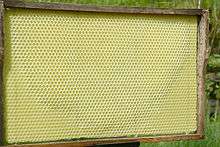Wax foundation


Wax foundation or honeycomb base is a plate made of wax with the base of the honeycomb. It is used in beekeeping to give the bees a foundation on which they can build the honeycomb.[1] Wax foundation is considered one of the most important inventions in modern beekeeping.[1]
Honeycomb built on wax foundation has important advantages over natural honeycomb:
- Bees make the honeycomb more quickly, and therefore can spend less energy on making the honeycomb and more on making honey.[1]
- The number of drone cells is lessened, which reduces the number of drones.[1]
- The cells have thicker bottoms, and thus the honeycomb is stronger and can withstand impacts, heat and centrifugation better.[1]
History
Wax foundation was invented by German Johannes Mehring in 1857,[1] not long after Langstroth constructed the Langstroth hive (1851).[2] Mehring's wax foundation had only the bottom of the cells, and today's base with the foundation of the cells was invented by US beekeeper Samuel Wagner.[1]
At first, wax foundations were made in the wax foundation press.[1] The first presses were made of wood, while later presses could be made of plaster, cement, and finally metal, which are the ones used today.[1] Wagner also invented the wax foundation rollers, but never perfected them; the first usable rollers were made by Amos Root and precise mechanic Alva Washburn in 1875.[3] In 1895. Detroit inventor Edward Weed invented rollers that can make wax foundation in a continuous roll.[4]
Use
A frame has to be wired so that the wax foundation could be inserted into it.[5] The foundation is then soldered with the wire by using a spur embedder or electric current. Also extant are wax foundations with embedded wire that only need to be inserted into the frame.[5]
If the wax foundation is used to produce raw honeycomb, wiring is not needed, but the foundation is affixed to the honeycomb section directly.[6] Special thin wax foundations are used for the production of the raw honeycomb.[6]
Wax foundations are made in various sizes, depending on the frame they will be inserted into. If needed, roller knife is used to cut wax foundations.[7]
References
- 1 2 3 4 5 6 7 8 9 Katalinić, Josip (1985). Pčelarstvo. Zagreb: Nakladni zavod Znanje. pp. 220–221.
- ↑ "Istorijski razvoj košnice". Union of Beekeeping Associations of Serbia. Retrieved 2013-08-31.
- ↑ Katalinić, Josip (1985). Pčelarstvo. Zagreb: Nakladni zavod Znanje. p. 222.
- ↑ Katalinić, Josip (1985). Pčelarstvo. Zagreb: Nakladni zavod Znanje. p. 224.
- 1 2 Katalinić, Josip (1985). Pčelarstvo. Zagreb: Nakladni zavod Znanje. pp. 229–231.
- 1 2 Katalinić, Josip (1985). Pčelarstvo. Zagreb: Nakladni zavod Znanje. pp. 484–485.
- ↑ Katalinić, Josip (1985). Pčelarstvo. Zagreb: Nakladni zavod Znanje. p. 233.